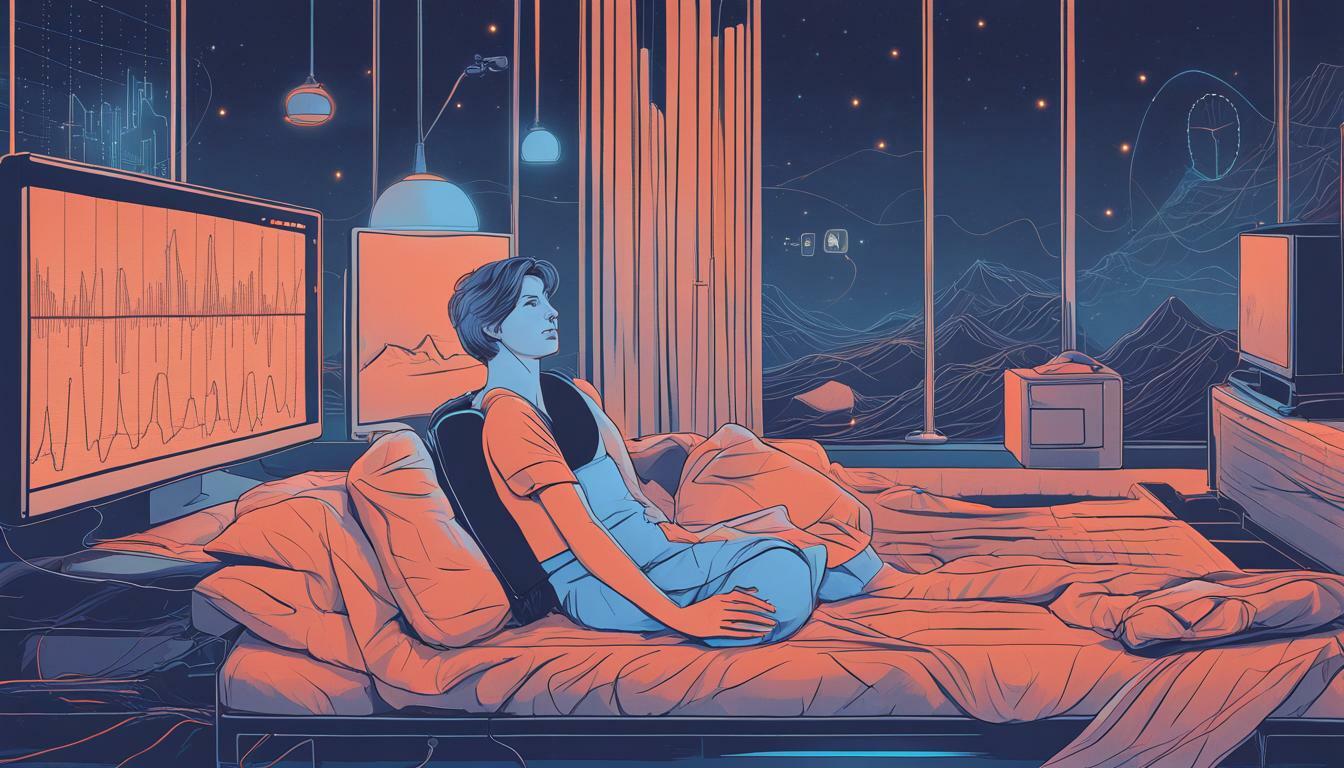As technology continues to permeate every aspect of our lives, we are becoming increasingly exposed to blue light, a type of light with a short wavelength that is emitted by electronic devices and artificial lighting. While blue light has many benefits, such as improving cognitive function and mood, there is growing concern about its impact on circadian rhythm, the body’s internal clock that regulates our sleep-wake cycle.
Circadian rhythm is crucial for maintaining optimal health, as it affects everything from our mood to our metabolism. Disruptions to circadian rhythm can lead to sleep problems, mood disorders, and other health issues. In this article, we will explore the link between blue light and circadian rhythm, and provide practical tips for minimizing blue light exposure and optimizing sleep habits.
Key Takeaways:
- Blue light, a type of light emitted by electronic devices and artificial lighting, can disrupt circadian rhythm, the body’s internal clock that regulates our sleep-wake cycle.
- Circadian rhythm is crucial for maintaining optimal health, and disruptions to circadian rhythm can lead to sleep problems, mood disorders, and other health issues.
- In the following sections, we will explore the link between blue light and circadian rhythm, and provide practical tips for minimizing blue light exposure and optimizing sleep habits.
Understanding Circadian Rhythm and Sleep-Wake Cycle
Circadian rhythm refers to the body’s internal clock that regulates various physiological processes, including the sleep-wake cycle. This cycle determines when we feel alert and when we feel drowsy and is essential for maintaining a regular sleep pattern and overall well-being.
The circadian rhythm is primarily influenced by the daily patterns of light and darkness. Exposure to natural light during the day helps regulate the body’s clock, while darkness triggers the production of the sleep hormone melatonin, preparing the body for rest.
However, exposure to blue light, especially in the evening and at night, can disrupt circadian rhythm and lead to sleep disruptions. This is because blue light has a similar wavelength to natural daylight and can trick the body into thinking it is still daytime, suppressing the production of melatonin and interfering with the sleep-wake cycle.
Studies have shown that even short-term exposure to blue light before bedtime can delay the onset of sleep, reduce rapid eye movement (REM) sleep, and lead to daytime fatigue. Prolonged exposure to blue light at night has also been linked to a range of health issues, including depression, obesity, and diabetes.
Reducing exposure to blue light in the evening can help regulate circadian rhythm and improve sleep quality. This can be achieved by avoiding bright screens and electronic devices for at least one hour before bedtime, using dim red lights in the bedroom, and wearing blue light-blocking glasses or using blue light filters on electronic devices.

Understanding Circadian Rhythm and Sleep-Wake Cycle: Key Takeaways
- Circadian rhythm regulates the sleep-wake cycle and is essential for overall well-being.
- Natural light and darkness help regulate the body’s internal clock.
- Exposure to blue light, especially at night, can disrupt circadian rhythm and lead to sleep disruptions.
- Reducing exposure to blue light in the evening can help regulate circadian rhythm and improve sleep quality.
The Link between Blue Light and Melatonin Suppression
Our bodies rely on the hormone melatonin to regulate our sleep and wake cycles. Normally, melatonin levels rise in the evening, signaling to our body that it’s time to wind down and prepare for sleep. However, exposure to blue light, especially in the evening, can disrupt the natural production of melatonin.
Research shows that exposure to blue light suppresses melatonin secretion, making it harder to fall asleep and stay asleep. This is particularly problematic for individuals who spend a lot of time looking at electronic screens, as these devices emit significant amounts of blue light.
The impact of blue light on sleep is concerning, as poor sleep quality can lead to a range of physical and mental health issues, including fatigue, decreased cognitive function, and increased risk of chronic diseases.

“A recent study demonstrated that participants who read from an e-reader before bedtime had a longer time-to-sleep onset, suppressed melatonin secretion, and experienced less REM sleep compared to those who read from a printed book.”
It’s important to be mindful of blue light exposure, especially in the evening hours, to promote healthy sleep and maintain a well-functioning circadian rhythm. In the next section, we will discuss how excessive blue light exposure can disrupt the sleep-wake cycle.
Blue Light Exposure and Sleep Disruption
Our modern lifestyles expose us to various sources of blue light, including electronic devices and artificial lighting. Excessive or inappropriate exposure to blue light can significantly disrupt our sleep patterns and lead to insomnia or poor sleep quality, ultimately impacting our overall health and well-being.
Research has shown that exposure to blue light in the evening can suppress melatonin production, leading to difficulty falling asleep and staying asleep throughout the night. To minimize blue light exposure and promote healthy sleep habits, it is essential to make adjustments in our daily routines, such as reducing screen time before bed and creating a sleep-friendly environment.
Adjusting device settings, using blue light filters or glasses, and choosing warm-hued lighting can also help reduce blue light exposure. Additionally, establishing a regular sleep-wake schedule and optimizing circadian rhythm through exposure to natural light during the day can further support healthy sleep habits.
Minimizing blue light exposure is crucial for maintaining optimal sleep quality and overall well-being. By taking proactive steps to reduce blue light exposure, we can ensure our circadian rhythms remain in balance, and we achieve restful, restorative sleep each night.
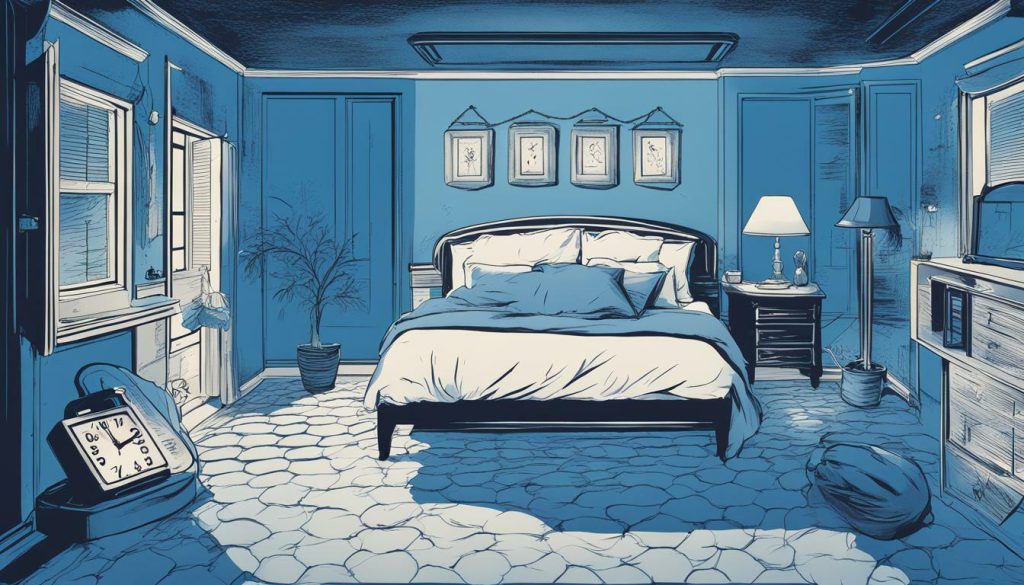
The Impact of Blue Light on Overall Health
While the effect of blue light on sleep is a significant concern, the implications of excessive blue light exposure extend far beyond the realm of sleep. Studies have linked blue light to a range of health issues, from weight gain and diabetes to mood disorders and even cancer.
The reason for this may lie in the way blue light affects the body’s internal clock, or circadian rhythm. The circadian rhythm regulates many bodily functions beyond just sleep, including metabolism, hormone production, and immune function. Disrupting this rhythm through exposure to blue light at inappropriate times may have far-reaching consequences for overall health.
One study found that exposure to blue light at night led to increased hunger and altered glucose metabolism, potentially contributing to weight gain and metabolic disorders. Another study linked blue light exposure to depression and other mood disorders, likely through its effect on the body’s natural production of serotonin.
Furthermore, research has shown that exposure to blue light at night may increase the risk of certain cancers, including breast and prostate cancer. This may be due to the suppression of melatonin production, which has been shown to have anti-cancer properties.
Overall, minimizing exposure to blue light is crucial for maintaining not just healthy sleep patterns, but overall well-being. By optimizing your body’s natural circadian rhythm, you can help prevent a range of health issues and improve your quality of life.

Research on Blue Light and Circadian Rhythm
Scientific research has increasingly focused on the effect of blue light on circadian rhythm and sleep patterns. Studies have found that exposure to blue light, particularly in the evening, can disrupt the body’s natural sleep-wake cycle and lead to poor sleep quality.
One study published in the Journal of Clinical Endocrinology & Metabolism found that just two hours of blue light exposure in the evening suppressed melatonin production by up to 22%.
Other research has suggested that blue light exposure may have long-term consequences beyond sleep disruption. A study published in the journal Obesity Reviews linked blue light exposure to an increased risk of obesity, while other studies have found associations between blue light exposure and mood disorders, such as depression and anxiety.
However, it is important to note that the research on blue light and circadian rhythm is still evolving, and there are some limitations and controversies in the studies. For example, some studies have found conflicting results regarding the optimal timing and duration of blue light exposure for circadian rhythm regulation.
Overall, the evidence suggests that blue light exposure has a significant impact on circadian rhythm and sleep quality, and further research is needed to fully understand the complex relationship between blue light and human health.
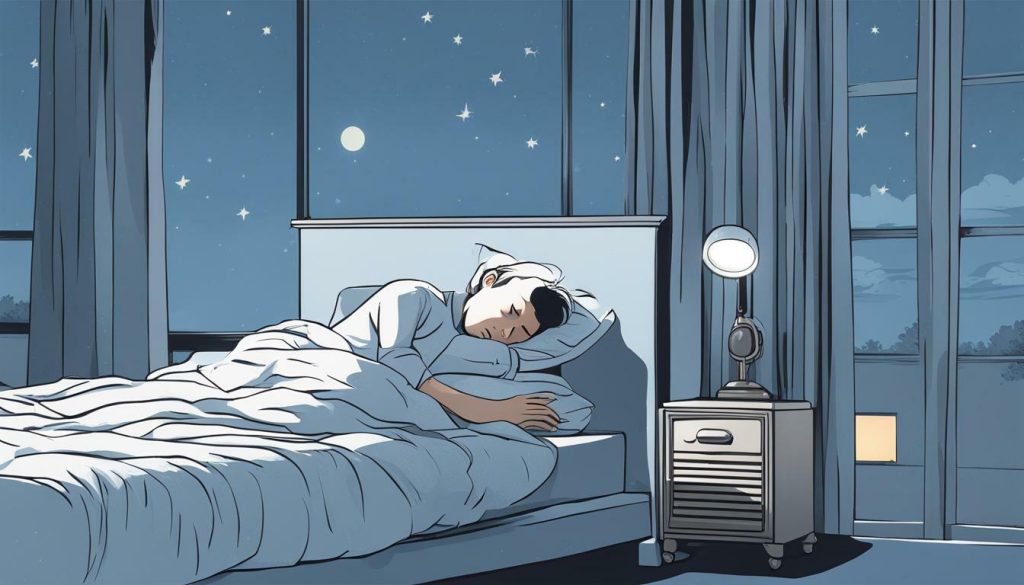
Strategies to Minimize Blue Light Exposure
Reducing blue light exposure in daily life is crucial to maintain healthy sleep patterns. Here are some practical tips to minimize blue light exposure:
- Adjust device settings: Most modern devices feature a “night mode” setting that reduces blue light emissions in the evening. Consider enabling this feature on your smartphone, tablet, laptop, and computer.
- Use blue light filters or glasses: Blue light filters or glasses can significantly reduce blue light exposure and protect your sleep quality. You can easily find them online or at your local eyewear store.
- Create a sleep-friendly environment: Replace bright overhead lights with warm, dim lighting for your bedroom. Use curtains or blinds to block outdoor light sources. Avoid using electronic devices in your bedroom before bedtime.
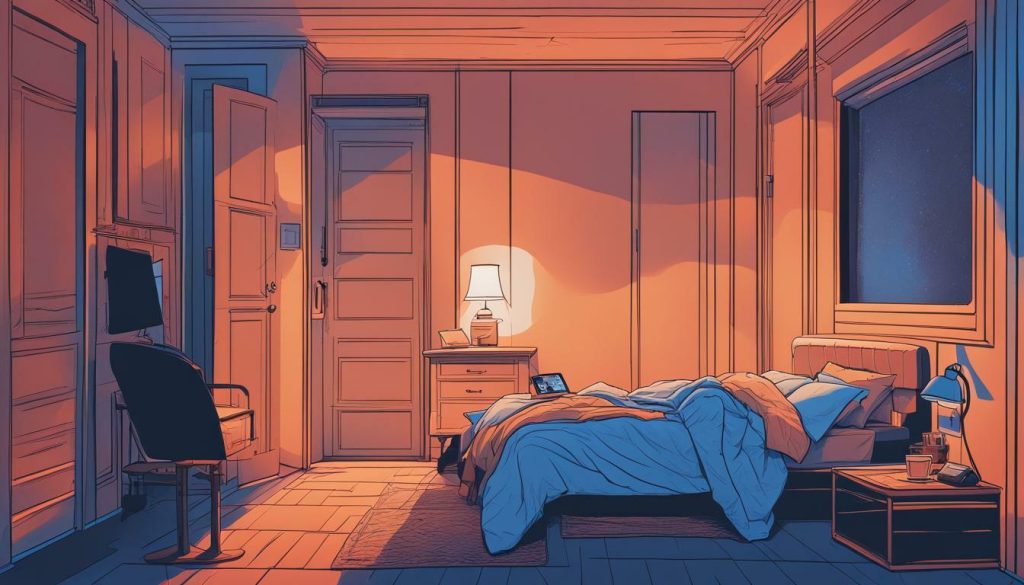
Establishing healthy sleep habits is also essential for minimizing blue light exposure and promoting overall well-being. Try to maintain a regular sleep-wake schedule, avoid caffeine and alcohol in the evening, and engage in relaxing activities before bedtime, such as reading or taking a warm bath.
Blue Light and Children’s Sleep Patterns
Children are particularly vulnerable to the impact of blue light on sleep due to their developing circadian rhythm and increased exposure to electronic devices. Studies have shown that excessive blue light exposure can disrupt their sleep patterns, leading to issues such as poor concentration, hyperactivity, and behavioral problems.
The American Academy of Pediatrics recommends limiting screen time for children to no more than two hours per day, and avoiding screens altogether for children under 18 months. For older children, it’s important to establish healthy sleep habits, such as maintaining a regular sleep-wake schedule and creating a sleep-friendly environment.
Parents and caregivers can also take steps to minimize blue light exposure for children, such as using blue light filters or glasses and setting device limits in the evenings. Encouraging outdoor time during the day can also help regulate children’s circadian rhythm and promote healthy sleep.

Long-term consequences of blue light exposure during critical developmental stages are not yet fully understood. Therefore, it is important to take proactive steps to protect children’s sleep health from excessive blue light exposure.
Blue Light and Shift Workers
Shift work disrupts the body’s natural circadian rhythm, leading to a variety of health issues. Exposure to blue light during night shifts can further exacerbate this disruption, affecting sleep quality and overall wellness. Studies have shown that exposure to blue light during the night can decrease melatonin secretion, which in turn affects the timing of sleep and wakefulness.
The consequences of circadian rhythm disruption and blue light are particularly severe for shift workers, who are already at a higher risk of developing sleep disorders and other health problems. In addition, the lack of exposure to natural light during the night shift can exacerbate the effects of blue light on the body’s internal clock.
Fortunately, there are strategies that shift workers can use to minimize the impact of blue light exposure on their sleep and overall health. First and foremost, employers can implement lighting solutions that mimic natural light patterns, which can help regulate circadian rhythms. Shift workers can also wear blue light blocking glasses during work hours and use apps that adjust device settings to reduce blue light exposure.
| Strategies for Shift Workers | Notes |
|---|---|
| Avoid blue light exposure before sleep | Avoid using electronic devices before bedtime |
| Create a sleep-conducive environment | Use dark curtains or eye masks to block out daylight during sleep hours |
| Establish regular sleep patterns | Stick to a consistent sleep schedule as much as possible |
Shift workers must also prioritize healthy sleep habits, such as maintaining a regular sleep schedule, avoiding caffeine and alcohol before bedtime, and creating a sleep-conducive environment. By minimizing blue light exposure and promoting healthy sleep habits, shift workers can mitigate the negative effects of circadian rhythm disruption and blue light on their sleep and overall well-being.
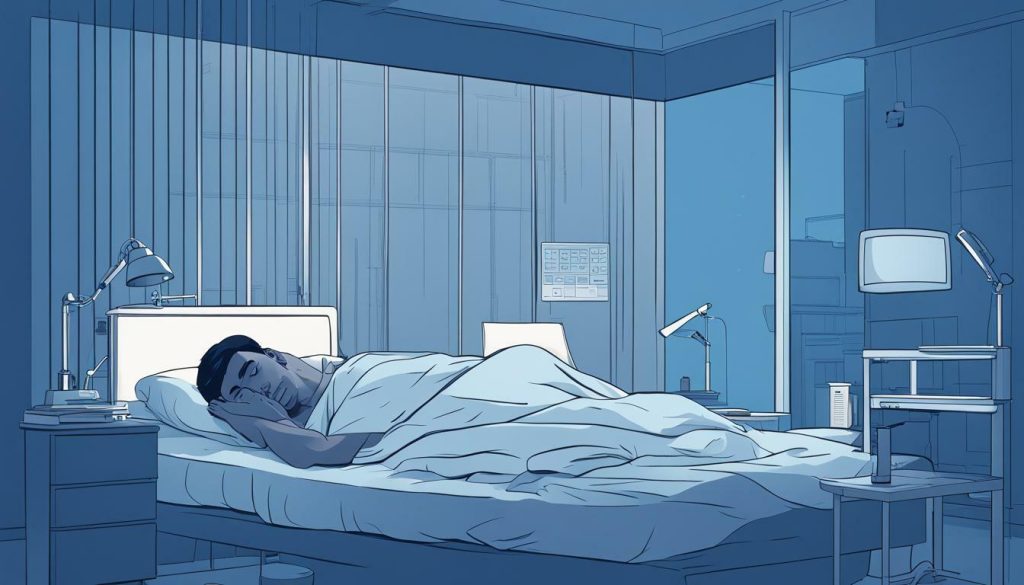
Conclusion
In today’s world, we are constantly surrounded by blue light-emitting devices and artificial lighting. While it has undoubtedly improved our lives, prolonged exposure to blue light can disrupt our circadian rhythm and negatively impact our health, particularly our sleep quality.
In this article, we have explored the effect of blue light on circadian rhythm and sleep-wake cycles. We have examined the link between blue light and melatonin suppression, as well as the potential long-term consequences of excessive blue light exposure on overall health.
It is essential to have a clear understanding of the impact of blue light exposure on our well-being and take practical steps to mitigate exposure. We have provided strategies for minimizing blue light exposure, establishing healthy sleep habits, and optimizing circadian rhythm.
Children and shift workers are particularly vulnerable to the harmful effects of blue light exposure. We have discussed protective measures for these groups to ensure their sleep health is not compromised.
In conclusion, managing blue light exposure is crucial for overall health and well-being. By prioritizing healthy sleep habits and minimizing blue light exposure, we can better regulate our circadian rhythm and improve our quality of life.
FAQ
Q: What is circadian rhythm?
A: Circadian rhythm is the internal biological clock that regulates the sleep-wake cycle and various body functions over a 24-hour period.
Q: What is the impact of blue light on circadian rhythm?
A: Blue light exposure, especially in the evening, can disrupt circadian rhythm and lead to sleep disruptions and poor sleep quality.
Q: How does blue light suppress melatonin?
A: Blue light exposure, particularly in the evening, can suppress the production of melatonin, a hormone that helps regulate sleep and the body’s internal clock.
Q: What are the sources of blue light exposure?
A: Blue light can be emitted by electronic devices, such as smartphones and computers, as well as artificial lighting sources, such as LED lights and fluorescent bulbs.
Q: What are the potential health implications of blue light exposure?
A: Studies have linked excessive blue light exposure to various health issues, including obesity, diabetes, and mood disorders.
Q: What does the research say about the effect of blue light on circadian rhythm?
A: Scientific research has shown that blue light can have a significant impact on circadian rhythm, but further studies are needed to fully understand the relationship.
Q: How can I minimize blue light exposure?
A: Practical tips include adjusting device settings, using blue light filters or glasses, and creating a sleep-friendly environment.
Q: How does blue light affect children’s sleep patterns?
A: Children are particularly vulnerable to the effects of blue light on circadian rhythm, and excessive exposure can have long-term consequences on their sleep health.
Q: What challenges do shift workers face in relation to blue light and circadian rhythm?
A: Shift workers often struggle with maintaining a healthy circadian rhythm due to irregular sleep schedules and increased artificial lighting exposure.
Q: What is the importance of managing blue light exposure?
A: Managing blue light exposure is crucial for maintaining a healthy circadian rhythm, promoting optimal sleep, and overall well-being.

